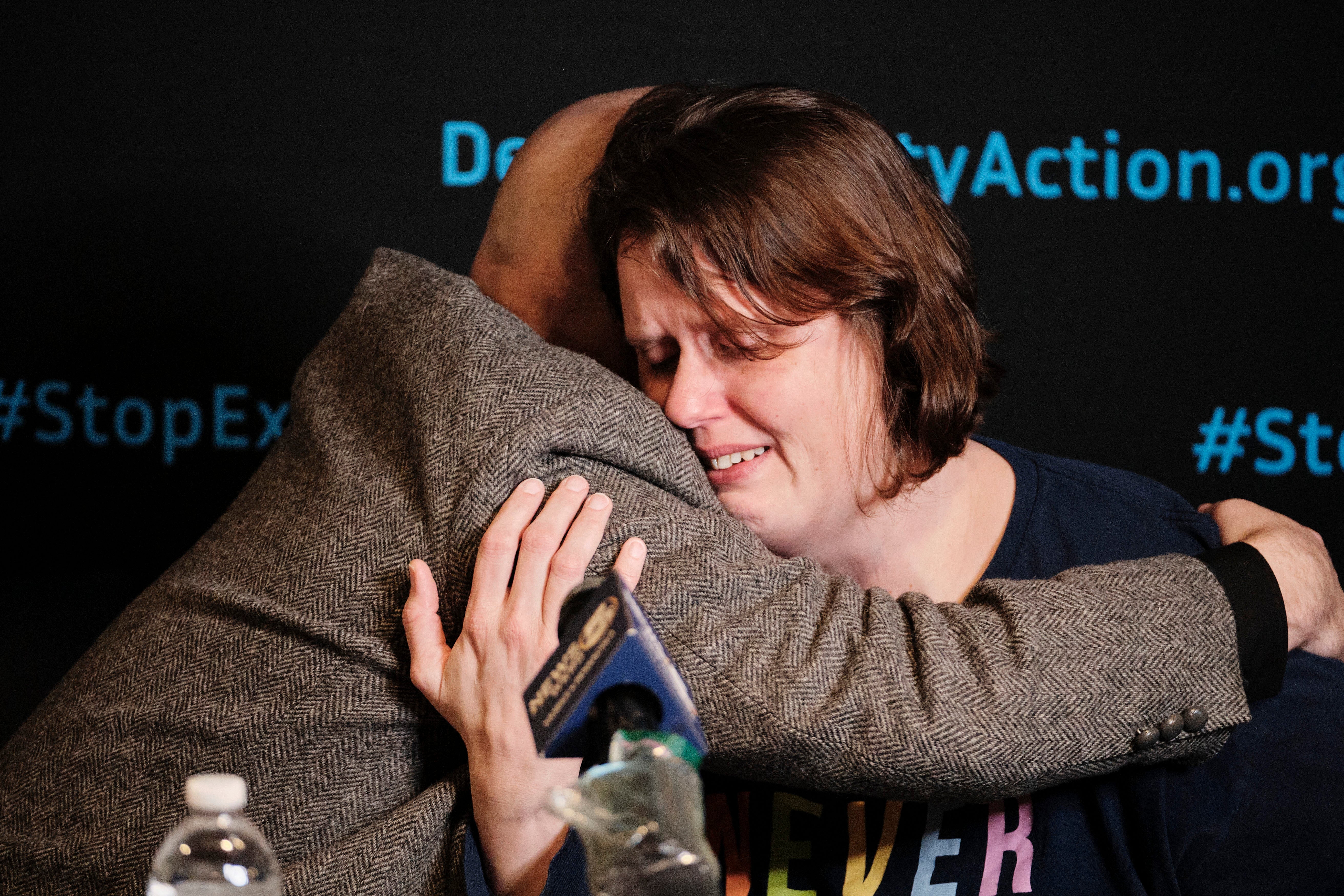Kenneth Smith’s nitrogen execution was ‘textbook’ and will be used again, Alabama AG says: updates
Attorney General Steve Marshall said that after Thursday night, ‘nitrogen hypoxia as a means of execution is no longer an untested method. It is a proven one’
Alabama death row inmate Kenneth Eugene Smith has been executed by nitrogen gas – making him the first person in US history to be put to death through the controversial method.
Smith, 58, was pronounced dead at 8.25pm CT on Thursday at the William C Holman Correctional Facility in Atmore, Alabama, almost three decades after he was convicted in the 1988 murder-for-hire plot of Elizabeth Sennett.
His religious adviser Reverend Jeff Hood, who witnessed the execution, told reporters what he saw was a man “struggling for their life” for a staggering 22 minutes.
The White House condemned the execution on Friday. “It is very troubling to us as an administration. It is very troubling to us here at the White House,” press secretary Karine Jean-Pierre said.
Alabama authorities insist the execution went to plan, despite predicting the untested method would lead to unconsciousness within seconds and death in minutes.
But, witnesses said Smith appeared conscious for several minutes, shaking and writhing on the gurney.
“We didn’t see somebody go unconscious in 30 seconds,” said Rev Hood. “What we saw was minutes of someone struggling for their life.”
Smith’s death came after the US Supreme Court denied a final, 11th-hour bid to stay of execution. The ruling received dissent from Justice Sonia Sotomayor who wrote that the state had selected Smith as a “guinea pig” by using the untested method.
Speaking at a news conference on Friday, Alabama Attorney General Steve Marshall said that 43 more death row inmates have elected to die by nitrogen hypoxia. People incarcerated on death row are able to chose their preferred method from electrocution, lethal injection or nitrogen hypoxia.
“What occurred last night was textbook,” AG Marshall said. “As of last night, nitrogen hypoxia as a means of execution is no longer an untested method. It is a proven one.”
Supreme Court denies Kenneth Smith stay of execution request
On Thursday evening the request for a stay of execution by Kenneth Smith’s lawyers was once again denied.
The ruling received dissent from Justice Sonia Sotomayor who wrote that the state of Alabama had selected Smith as a “guinea pig” by using the untested method of execution – suffocation by nitrogen gas.
“The world is watching. This court yet again allows Alabama to ‘experiment... with human life’,” Justice Sotomayor wrote.
Supreme Court justices dissent to denial of Smith’s application to stay execution
Justice Elena Kagan and Justice Ketanji Brown Jackson also dissented to the Supreme COurt’s denial of the application for a stay of execution for Kenneth Smith.
In the court ruling the pair, like Justice Sonia Sotomayor expressed concern at the “novel” method of execution – suffocation with nitrogen gas. “The State's protocol was developed only recently, and is even now under revision to prevent Smith from choking on his own vomit,” the wrote.
“The State has declined to provide Smith with all the discovery respecting its protocol which he has requested. And Smith has a well-documented medical condition posing special risks from the State's newly chosen method of execution.”
Kenneth Smith put to death using nitrogen gas in first-of-its-kind US execution
Alabama Death Row inmate Kenneth Eugene Smith has been executed with nitrogen gas.
It marks the first time the US has used the method to put an individual to death, and has brought the debate over capital punishment in the US back into the spotlight.
Alabama state officials said the method would be humane, but critics called it cruel and experimental.
Officials said Smith, 58, was pronounced dead at 8:25 p.m. at an Alabama prison after breathing pure nitrogen gas through a face mask to cause oxygen deprivation, according to The Associated Press.
It marked the first time that a new execution method has been used in the United States since lethal injection, now the most commonly used method, was introduced in 1982.
Alabama Governor says Smith case ‘can finally be put to rest'
In a statement following Kenneth Smith’s execution, Alabama Governor Kay Ivey said the case could “finally be put to rest”.
“On March 18, 1988, 45-year-old Elizabeth Sennett’s life was brutally taken from her by Kenneth Eugene Smith,” Governor Ivey said.
“After more than 30 years and attempt after attempt to game the system, Mr. Smith has answered for his horrendous crimes.
“The execution was lawfully carried out by nitrogen hypoxia, the method previously requested by Mr Smith as an alternative to lethal injection. At long last, Mr. Smith got what he asked for, and this case can finally be put to rest.
“I pray that Elizabeth Sennett’s family can receive closure after all these years dealing with that great loss.”
Death row inmate’s statement before nitrogen execution
Alabama death row inmate Kenneth Eugene Smith in his final statement said humanity took a step backwards in Alabama.
“Tonight Alabama causes humanity to take a step backwards. ... I’m leaving with love, peace and light,” he said.
He made the “I love you sign” with his hands toward family members who were witnesses. “Thank you for supporting me. Love, love all of you,” Smith said.
Kenneth Smith was ‘terrified’ at the possible torture
Rev Jeff Hood, who was with Kenneth Simth during his last hours, said the inmate was terrified before the execution.
“He’s terrified at the torture that could come. But he’s also at peace. One of the things he told me is he is finally getting out,” Mr Hood told the Associated Press.
Who was Elizabeth Dorlene Sennett?
Alabama death row inmate Kenneth Eugene Smith was executed on Thursday, almost three decades after he was convicted in the 1988 murder-for-hire plot of Elizabeth Dorlene Sennett.
Sennett was found dead in her home on 18 March 1988 with eight stab wounds in the chest and one on each side of her neck. Smith was one of two men convicted in the killing. The other, John Forrest Parker, was executed in 2010.
Prosecutors said they were each paid $1,000 (£786) to kill Sennett on behalf of her pastor husband, who was deeply in debt and wanted to collect on insurance. The husband, Charles Sennett Sr, killed himself when the investigation focused on him as a suspect, according to court documents.
Smith’s 1989 conviction was overturned, but he was convicted again in 1996. The jury recommended a life sentence by 11-1, but a judge overrode that and sentenced him to death.
The victim’s son, Charles Sennett Jr, earlier told WAAY-TV that Smith “has to pay for what he’s done”.
“And some of these people out there say, ‘Well, he doesn’t need to suffer like that.’ Well, he didn’t ask Mama how to suffer?” he said.
“They just did it. They stabbed her — multiple times.”
Smith feared nitrogen gas method would be used by more states
In an interview days before his execution, the death row inmate in Alabama warned Americans that if his nitrogen execution were successful that process could be adopted by other states.
Kenneth Eugene Smith on Thursday became the first person in US history to be executed with nitrogen gas.
Smith told The Guardian in a phone call from his prison cell that he was not ready to die and had been diagnosed with PTSD caused by his first failed execution attempt. He said he suffered from sleeplessness and anxiety.
Smith said he was terrified by the prospect of vomiting in the mask leading and had appealed to people to show mercy for inmates facing judicial killings.
“You know, brother, I’d say, ‘Leave room for mercy’. That just doesn’t exist in Alabama. Mercy really doesn’t exist in this country when it comes to difficult situations like mine,” he told the newspaper.
“I fear that it will be successful, and you will have a nitrogen system coming to your state very soon,” he added.
Concern over the use of nitrogen gas in inmate executions
Alabama death row inmate Kenneth Eugene Smith became the first person in American history to be executed with nitrogen gas.
UN human rights experts and lawyers for Smith had sought to prevent it, saying the method was risky, experimental and could lead to a torturous death or non-fatal injury.
The state has called its new protocol “the most painless and humane method of execution known to man.”Ravina Shamdasani, a spokeswoman for the UN Human Rights office, said: “This could amount to torture or other cruel or degrading treatment or punishment under international human rights law.”
“Nitrogen gas has never been used in the United States to execute human beings.”
Lawmakers in Oklahoma and Mississippi have also approved similar nitrogen-asphyxiation execution protocols in recent years, but have yet to put them into practice.
“There are so many unanswered questions about this protocol and I think there are real concerns that Smith will suffer a cruel and painful death, while possibly endangering others in the execution chamber,” Robin Maher, executive director of the Death Penalty Information Center, said in a statement.
In an appeal filed in November, Smith’s attorneys argued that the method “can cause severe and permanent injuries short of death, including a persistent vegetative state, stroke, or the painful sensation of suffocation”.
“Just the idea of using gas for executions is an affront to our community,” Mike Zoosman, the co-founder of L’chaim, was quoted by The Guardian as saying.
“The Nazi legacy of experimentation to find the most expeditious way to rid our community of undesirable prisoners is an undercurrent for anyone who is aware of that history that should not be repeated in Alabama, or anywhere.”
Kenneth Smith’s wife breaks down during presser







Join our commenting forum
Join thought-provoking conversations, follow other Independent readers and see their replies
1Comments